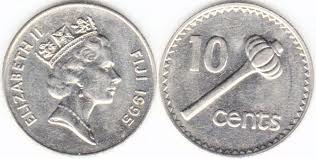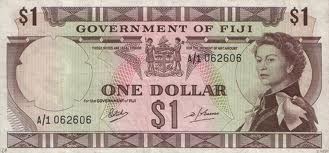|


The dollar (currency sign: $; currency code: FJD) has been the currency of Fiji since 1969 and was also the currency between 1867 and 1873. It is normally abbreviated with the dollar sign $, or alternatively FJ$ to distinguish it from other dollar-denominated currencies. It is divided into 100 cents.
History
First dollar (1867 - 1873)
Fiji issued paper money denominated in dollars and cents between 1867 and 1873. The dollar was equal in value to the silver US dollar. The dollar was replaced by the British pound, and in time by the Fijian pound, following Fiji becoming a British colony.
Second dollar (1969 - Present)
The dollar was reintroduced in 1969, replacing the Fijian pound at a rate of 1 pound = 2 dollars, or 10 shillings = FJ$1. The coins and banknotes continue to feature Queen Elizabeth II, despite Fiji having been a republic since 1987.
Decimalisation origins
Fiji followed the pattern of South Africa, Australia, and New Zealand in that when it adopted the decimal system, it decided to use the half pound unit as opposed to the pound unit of account. The choice of the name dollar was motivated by the fact that the reduced value of the new unit corresponded more closely to the value of the US dollar than it did to the pound sterling.
Coinage
In 1969, coins were introduced in denominations of 1¢, 2¢, 5¢, 10¢ & 20¢, with a 50¢ coin issued in 1975. The coins had the same sizes and compositions as the corresponding Australian coins, with the 50 cents matching the cupronickel dodecagonal type introduced in Australia in 1969. In 1990, new compositions were introduced, with copper-plated zinc used for the 1¢ and 2¢ coins, and nickel-plated steel for the 5¢, 10¢, 20¢ & 50¢. An aluminium-bronze $1 coin was introduced in 1995. 2009 saw the introduction of a new smaller coinage from 5 to 50 cents.
Banknotes
First dollar
In 1867, the government treasury issued 1 dollar notes. These were followed by notes for $1, $5, $10, $25 and $50 issued between 1871 and 1873. Also between 1871 and 1873, King Cakobau issued notes in denominations of 12½¢, 25¢, 50¢, 100¢ and $5. Levuka (on Ovalau island) issued $1 and $5 notes during the 1870s.
Second dollar
In 1969, the government introduced notes in denominations of 50 cents, $1, $2, $5, $10 and $20. The Central Monetary Authority took over the issuance of paper money in 1974, issuing the same denominations, although the 50¢ note was withdrawn by 1980. In 1987, the Reserve Bank of Fiji began issuing notes. The $1 note was replaced by a coin in 1995, the same year that a $50 note was introduced, followed by a $100 note in 2007. Denominations of banknote currently in circulation are:
* $2
* $5
* $10
* $20
* $50
* $100
Current status & value
On 16 August 2005, Finance Minister Ratu Jone Kubuabola announced that the Cabinet had approved the introduction of a $100 banknote and the withdrawal of the 2 cent coin, as its minting cost exceeded its face value. Kubuabola said that the $100 banknote would measure 156 × 67 mm, with the other banknotes receding at 5 mm towards the lowest banknote denomination. The portrait of Queen Elizabeth II would remain on all banknotes, he added, obviously in answer to calls from some politicians to remove the Queen's portrait from the currency after 18 years as an republic. Fiji is, however, a member of the Commonwealth, and Queen Elizabeth is recognized as Paramount Chief of the Great Council of Chiefs of Fiji. Her portrait was updated to a more mature one, which was released in 2007, becoming the fourth portrait of the Queen to appear on Fijian currency.
The Reserve Bank of Fiji Governor Savenaca Narube announced on 11 February 2006 that polymer plastic coated notes would be introduced, featuring images of local people, culture, trade and industry. The new notes, which would be ready for distribution in early 2007, would vary in size, Narube said.
The Fijian dollar's exchange value towards the US dollar tends to be USD 1 = (FJD 1.7 ... FJD 1.9).
The text on this page has been made available under the Creative Commons Attribution-ShareAlike License and Creative Commons Licenses
|
